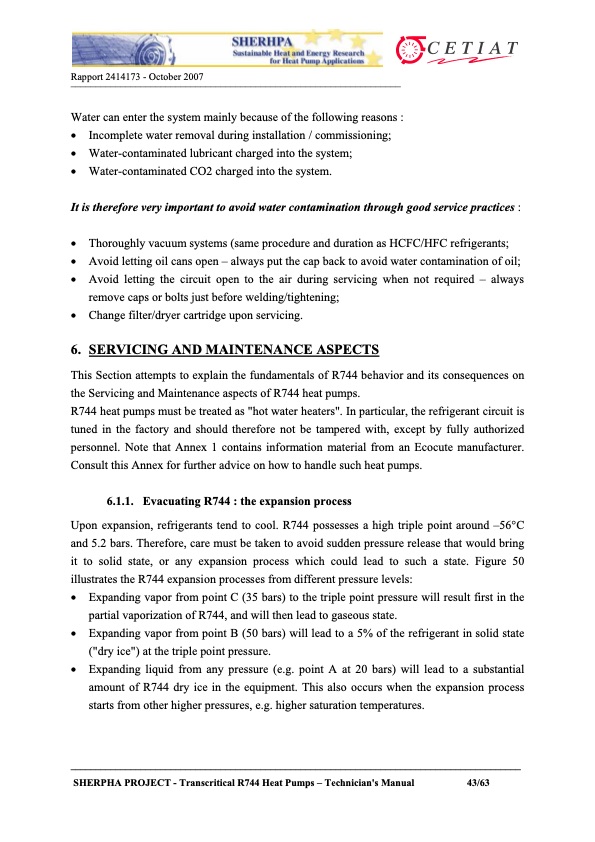
PDF Publication Title:
Text from PDF Page: 044
Rapport 2414173 - October 2007 __________________________________________________________________ Water can enter the system mainly because of the following reasons : • Incomplete water removal during installation / commissioning; • Water-contaminated lubricant charged into the system; • Water-contaminated CO2 charged into the system. It is therefore very important to avoid water contamination through good service practices : • Thoroughly vacuum systems (same procedure and duration as HCFC/HFC refrigerants; • Avoid letting oil cans open – always put the cap back to avoid water contamination of oil; • Avoid letting the circuit open to the air during servicing when not required – always remove caps or bolts just before welding/tightening; • Change filter/dryer cartridge upon servicing. 6. SERVICING AND MAINTENANCE ASPECTS This Section attempts to explain the fundamentals of R744 behavior and its consequences on the Servicing and Maintenance aspects of R744 heat pumps. R744 heat pumps must be treated as "hot water heaters". In particular, the refrigerant circuit is tuned in the factory and should therefore not be tampered with, except by fully authorized personnel. Note that Annex 1 contains information material from an Ecocute manufacturer. Consult this Annex for further advice on how to handle such heat pumps. 6.1.1. Evacuating R744 : the expansion process Upon expansion, refrigerants tend to cool. R744 possesses a high triple point around –56°C and 5.2 bars. Therefore, care must be taken to avoid sudden pressure release that would bring it to solid state, or any expansion process which could lead to such a state. Figure 50 illustrates the R744 expansion processes from different pressure levels: • Expanding vapor from point C (35 bars) to the triple point pressure will result first in the partial vaporization of R744, and will then lead to gaseous state. • Expanding vapor from point B (50 bars) will lead to a 5% of the refrigerant in solid state ("dry ice") at the triple point pressure. • Expanding liquid from any pressure (e.g. point A at 20 bars) will lead to a substantial amount of R744 dry ice in the equipment. This also occurs when the expansion process starts from other higher pressures, e.g. higher saturation temperatures. __________________________________________________________________________________________ SHERPHA PROJECT - Transcritical R744 Heat Pumps – Technician's Manual 43/63PDF Image | Transcritical R744 (CO2) Heat Pumps 2017

PDF Search Title:
Transcritical R744 (CO2) Heat Pumps 2017Original File Name Searched:
Manuel-CO2.pdfDIY PDF Search: Google It | Yahoo | Bing
CO2 Organic Rankine Cycle Experimenter Platform The supercritical CO2 phase change system is both a heat pump and organic rankine cycle which can be used for those purposes and as a supercritical extractor for advanced subcritical and supercritical extraction technology. Uses include producing nanoparticles, precious metal CO2 extraction, lithium battery recycling, and other applications... More Info
Heat Pumps CO2 ORC Heat Pump System Platform More Info
| CONTACT TEL: 608-238-6001 Email: greg@infinityturbine.com | RSS | AMP |